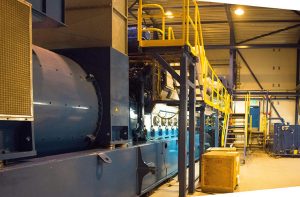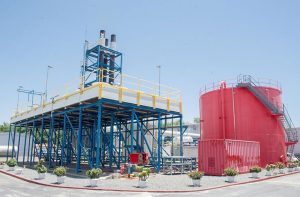THE Power Producers and Distributors Inc. (PPDI) is in the process of drafting a three-year strategic plan with major focus on utilising hydropower and associated natural gas to generate electricity at the New Kingston and Vreed-en-Hoop power plants once Guyana starts producing petroleum in 2020.
PPDI Board Chairman, Mark Bender, and the Chief Executive Officer (CEO), Arron Fraser, made the disclosure on Thursday, while giving the media an extensive tour of the Kingston, New Kingston and Vreen-en-Hoop Power plants.
PPDI, which took over the operations of Wärtsilä in December 2016, manages the operations and maintenance of the Kingston, New Kingston, Vreed-en-Hoop and Garden of Eden Power plants on behalf of the Guyana Power and Light (GPL) at a fixed rate of US$16.87 per megawatt of electricity.
In making the disclosure, Bender explained that the strategic plan is in keeping with Guyana’s move towards the use of 100 per cent renewable energy by 2025.
“In that regard, there are a number of options being considered. The two most significant ones at this time are hydropower and associated natural gas, once the oil and gas production starts,” Bender told reporters, while standing in the control room at the New Kingston Power Plant at Water Street, Georgetown.

Currently, the power plants generate electricity using Heavy Fuel Oil (HFO). Bender said though that DDPI only has one client – GPL – the strategic plan is being drafted in manner that allows the company to expand, while remaining “relevant” as the A Partnership for National Unity + Alliance for Change (APNU+AFC) Government moves ahead with its to plan to have electricity produced entirely by clean and renewable sources of energy by 2025.
“We are responding to the announced policy, and of course, use of natural gas is not anything new. In the past we would have had to import it…. Once you are producing petroleum, you will get associated natural gas, so now we will get our own resource rather than having to import it, which will impact on the cost obviously,” Bender stated.
Within the “next couple of weeks”, the strategic plan, Bender noted will be completed, allowing for it to be reviewed by Public Infrastructure Minister, David Patterson.
Rest With Cabinet
Weighing in on the issue, the CEO made it clear that the decision to use hydropower and/or associated natural gas lies with the Cabinet. Fraser noted, however, that the two newer plants, New Kingston and Vreed-en-Hoop, can be converted to use associated natural gas.
This, he said, translates to more savings, simply because there will be less “wear and tear” on the engines when compared to the use of HFO. The New Kingston Power Plant has five units, while the Vreed-en-Hoop Power Station has three engines. Once the green light is given for the use of associated natural gas in the future, adjustments will be made to the ignition system to accommodate the renewable energy.
“About four years ago when we were at Wärtsilä, we had started efforts to see what that would cost and I think ballpark figure to convert one engine was about 300, 000 euros back then, to covert one engine. Since then we haven’t looked at the updated cost,” Fraser pointed out.
However, he maintained that the decision to use natural gas and/or hydropower “rest with Cabinet” but said the company will continue to position itself as the country continues to develop.
EFFICIENT OPERATION
Meanwhile, in assessing DDPI’s performance for the first seven months of its operations, both Bender and Fraser agreed that the company has maintained a very efficient operation meeting the demands of GPL.
“The scope of our service mirrors that of our predecessor. In terms of physical boundaries, PPDI responsibility for power generation stops at the outgoing feeder of the power plant – transmission and distribution remains GPL’s responsibility,” the CEO stated, while pointing out that the total electrical output of the plants under PPDI’s management is 106.4 megawatts annually.

It was further noted that in the Operations and Maintenance Agreement, DDPI offers performance guarantees to GPL in three critical areas: availability, plant heat rate (which is measures fuel consumption), and lube oil consumption.
According to Fraser, DDPI generated 375,285Mwh for 2017 when compared to 381,347Mwh for the same period last year. Though the company has generated less electricity thus far for 2017, Fraser said production is dependent on the demands made by GPL.
“Our generation is tied to the demand of the grid, so though we might have generated less this year, our output is strictly mandated by what GPL requires, which is essentially what the customer requires,” the CEO explained.
It was also noted that for 2017 the company utilised less than HFO when compared to 2016. Its availability also increased to 93.43 per cent from a low of 92.00 per cent in 2016. In addition to Bender and Fraser, Gary Hall, Deputy Chief Executive Officer (DCEO), participated in the onsite visit.



.jpg)








